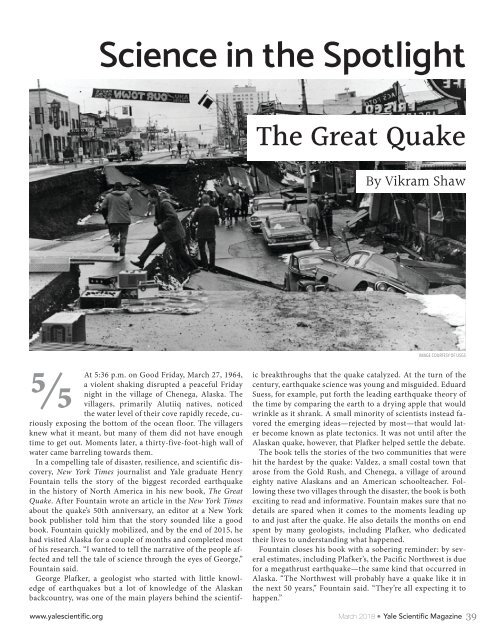YSM Issue 91.1
You also want an ePaper? Increase the reach of your titles
YUMPU automatically turns print PDFs into web optimized ePapers that Google loves.
Science in the Spotlight<br />
The Great Quake<br />
By Vikram Shaw<br />
IMAGE COURTESY OF USGS<br />
5/5<br />
At 5:36 p.m. on Good Friday, March 27, 1964,<br />
a violent shaking disrupted a peaceful Friday<br />
night in the village of Chenega, Alaska. The<br />
villagers, primarily Alutiiq natives, noticed<br />
the water level of their cove rapidly recede, curiously<br />
exposing the bottom of the ocean floor. The villagers<br />
knew what it meant, but many of them did not have enough<br />
time to get out. Moments later, a thirty-five-foot-high wall of<br />
water came barreling towards them.<br />
In a compelling tale of disaster, resilience, and scientific discovery,<br />
New York Times journalist and Yale graduate Henry<br />
Fountain tells the story of the biggest recorded earthquake<br />
in the history of North America in his new book, The Great<br />
Quake. After Fountain wrote an article in the New York Times<br />
about the quake’s 50th anniversary, an editor at a New York<br />
book publisher told him that the story sounded like a good<br />
book. Fountain quickly mobilized, and by the end of 2015, he<br />
had visited Alaska for a couple of months and completed most<br />
of his research. “I wanted to tell the narrative of the people affected<br />
and tell the tale of science through the eyes of George,”<br />
Fountain said.<br />
George Plafker, a geologist who started with little knowledge<br />
of earthquakes but a lot of knowledge of the Alaskan<br />
backcountry, was one of the main players behind the scientific<br />
breakthroughs that the quake catalyzed. At the turn of the<br />
century, earthquake science was young and misguided. Eduard<br />
Suess, for example, put forth the leading earthquake theory of<br />
the time by comparing the earth to a drying apple that would<br />
wrinkle as it shrank. A small minority of scientists instead favored<br />
the emerging ideas—rejected by most—that would later<br />
become known as plate tectonics. It was not until after the<br />
Alaskan quake, however, that Plafker helped settle the debate.<br />
The book tells the stories of the two communities that were<br />
hit the hardest by the quake: Valdez, a small costal town that<br />
arose from the Gold Rush, and Chenega, a village of around<br />
eighty native Alaskans and an American schoolteacher. Following<br />
these two villages through the disaster, the book is both<br />
exciting to read and informative. Fountain makes sure that no<br />
details are spared when it comes to the moments leading up<br />
to and just after the quake. He also details the months on end<br />
spent by many geologists, including Plafker, who dedicated<br />
their lives to understanding what happened.<br />
Fountain closes his book with a sobering reminder: by several<br />
estimates, including Plafker’s, the Pacific Northwest is due<br />
for a megathrust earthquake—the same kind that occurred in<br />
Alaska. “The Northwest will probably have a quake like it in<br />
the next 50 years,” Fountain said. “They’re all expecting it to<br />
happen.”<br />
www.yalescientific.org<br />
March 2018<br />
Yale Scientific Magazine<br />
39


















